High expression of PTPRM predicts poor prognosis and promotes tumor growth and lymph node metastasis in cervical cancer
- PMID: 32826853
- PMCID: PMC7443137
- DOI: 10.1038/s41419-020-02826-x
High expression of PTPRM predicts poor prognosis and promotes tumor growth and lymph node metastasis in cervical cancer
Abstract
The prognosis for cervical cancer (CCa) patients with lymph node metastasis (LNM) is dismal. Elucidation of the molecular mechanisms underlying LNM may provide clinical therapeutic strategies for CCa patients with LNM. However, the precise mechanism of LNM in CCa remains unclear. Herein, we demonstrated that protein tyrosine phosphatase receptor type M (PTPRM), identified from TCGA dataset, was markedly upregulated in CCa with LNM and correlated with LNM. Moreover, PTPRM was an independent prognostic factor of CCa patients in multivariate Cox's proportional hazards model analysis and associated with poor prognosis. Furthermore, through gain-of-function and loss-of-function approaches, we found that PTPRM promoted CCa cells proliferation, migration, invasion, lymphangiogenesis, and LNM. Mechanistically, PTPRM promoted epithelial-mesenchymal transition (EMT) via Src-AKT signaling pathway and induced lymphangiogenesis in a VEGF-C dependent manner, resulting in LNM of CCa. Importantly, knockdown of PTPRM dramatically reduced LNM in vivo, suggesting that PTPRM plays an important role in the LNM of CCa. Taken together, our findings uncover a novel molecular mechanism in the LNM of CCa and identify PTPRM as a novel prognostic factor and potential therapeutic target for LNM in CCa.
Conflict of interest statement
The authors declare that they have no conflict of interest.
Figures
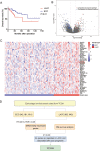
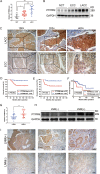
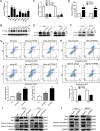
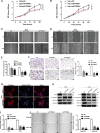
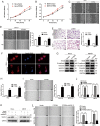
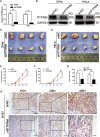
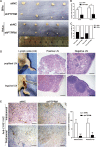
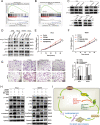
Similar articles
-
FABP5 promotes lymph node metastasis in cervical cancer by reprogramming fatty acid metabolism.Theranostics. 2020 May 17;10(15):6561-6580. doi: 10.7150/thno.44868. eCollection 2020. Theranostics. 2020. PMID: 32550890 Free PMC article.
-
COX-2 expression is correlated with VEGF-C, lymphangiogenesis and lymph node metastasis in human cervical cancer.Microvasc Res. 2011 Sep;82(2):131-40. doi: 10.1016/j.mvr.2011.04.011. Epub 2011 May 4. Microvasc Res. 2011. PMID: 21600223
-
FASN promotes lymph node metastasis in cervical cancer via cholesterol reprogramming and lymphangiogenesis.Cell Death Dis. 2022 May 21;13(5):488. doi: 10.1038/s41419-022-04926-2. Cell Death Dis. 2022. PMID: 35597782 Free PMC article.
-
The Role of microRNAs in Cholangiocarcinoma.Int J Mol Sci. 2021 Jul 16;22(14):7627. doi: 10.3390/ijms22147627. Int J Mol Sci. 2021. PMID: 34299246 Free PMC article. Review.
-
Targeting Lymphangiogenesis and Lymph Node Metastasis in Liver Cancer.Am J Pathol. 2021 Dec;191(12):2052-2063. doi: 10.1016/j.ajpath.2021.08.011. Epub 2021 Sep 9. Am J Pathol. 2021. PMID: 34509441 Free PMC article. Review.
Cited by
-
Downregulation of LNMAS orchestrates partial EMT and immune escape from macrophage phagocytosis to promote lymph node metastasis of cervical cancer.Oncogene. 2022 Mar;41(13):1931-1943. doi: 10.1038/s41388-022-02202-3. Epub 2022 Feb 12. Oncogene. 2022. PMID: 35152264 Free PMC article.
-
Analysis of the Mutational Landscape of Osteosarcomas Identifies Genes Related to Metastasis and Prognosis and Disrupted Biological Pathways of Immune Response and Bone Development.Int J Mol Sci. 2023 Jun 21;24(13):10463. doi: 10.3390/ijms241310463. Int J Mol Sci. 2023. PMID: 37445641 Free PMC article.
-
[Vasohibin-2 promotes proliferation and metastasis of cervical cancer cells by regulating epithelial-mesenchymal transition].Nan Fang Yi Ke Da Xue Xue Bao. 2022 Jul 20;42(7):966-975. doi: 10.12122/j.issn.1673-4254.2022.07.02. Nan Fang Yi Ke Da Xue Xue Bao. 2022. PMID: 35869758 Free PMC article. Chinese.
-
Biological and Clinicopathological Characteristics of OPN in Cervical Cancers.Front Genet. 2022 May 20;13:836509. doi: 10.3389/fgene.2022.836509. eCollection 2022. Front Genet. 2022. PMID: 35669197 Free PMC article.
-
Genomic Assessment of Cancer Susceptibility in the Threatened Catalina Island Fox (Urocyon littoralis catalinae).Genes (Basel). 2022 Aug 22;13(8):1496. doi: 10.3390/genes13081496. Genes (Basel). 2022. PMID: 36011407 Free PMC article.
References
Publication types
MeSH terms
Substances
LinkOut - more resources
Full Text Sources
Medical
Molecular Biology Databases
Miscellaneous

